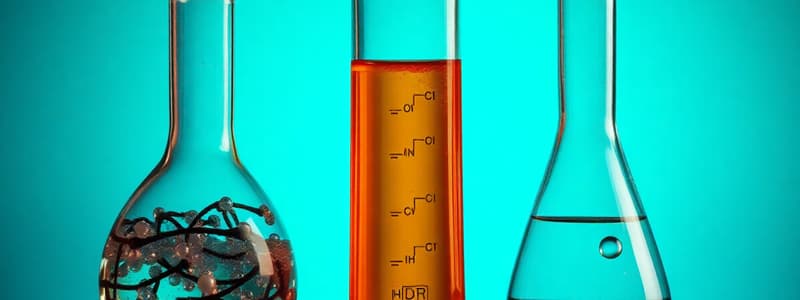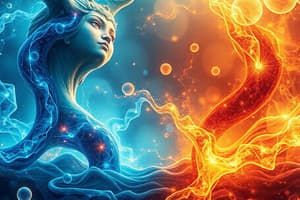Podcast
Questions and Answers
What occurs during a chemical change?
What occurs during a chemical change?
- Only heat is involved without any substance transformation.
- The structural formula of a substance remains unchanged.
- A substance is converted into new substances with different properties. (correct)
- A substance retains its original properties.
Which of the following best describes a combination reaction?
Which of the following best describes a combination reaction?
- It splits a substance into two or more simpler substances.
- It releases energy by burning a carbon-containing compound.
- It combines two or more substances into a single new substance. (correct)
- It involves the swapping of positive ions between two reactants.
What happens in a double replacement reaction?
What happens in a double replacement reaction?
- One element in a compound replaces another element.
- Substances combine to form one product.
- A carbon compound reacts with oxygen.
- Positive ions of two reactants swap places. (correct)
What defines oxidation in oxidation-reduction reactions?
What defines oxidation in oxidation-reduction reactions?
Which scenario represents reduction in a chemical reaction?
Which scenario represents reduction in a chemical reaction?
What does VESPR stand for in the context of electron groups around a central atom?
What does VESPR stand for in the context of electron groups around a central atom?
How many electron groups around a central atom result in a tetrahedral molecular shape?
How many electron groups around a central atom result in a tetrahedral molecular shape?
What type of bond forms when the electronegativity difference between two atoms is very high?
What type of bond forms when the electronegativity difference between two atoms is very high?
Which statement is true regarding intermolecular forces and boiling/melting points?
Which statement is true regarding intermolecular forces and boiling/melting points?
What type of intermolecular force can occur due to temporary dipoles in nonpolar molecules?
What type of intermolecular force can occur due to temporary dipoles in nonpolar molecules?
What is the definition of theoretical yield?
What is the definition of theoretical yield?
How do you determine the limiting factor between two reactants?
How do you determine the limiting factor between two reactants?
What does percent yield measure?
What does percent yield measure?
If a reaction has an actual yield of 50 grams and a theoretical yield of 100 grams, what is the percent yield?
If a reaction has an actual yield of 50 grams and a theoretical yield of 100 grams, what is the percent yield?
What occurs when a reaction does not go to completion?
What occurs when a reaction does not go to completion?
What is the significance of a limiting reactant in a chemical reaction?
What is the significance of a limiting reactant in a chemical reaction?
How many particles are in one mole of a substance?
How many particles are in one mole of a substance?
What is the correct procedure to convert grams of substance A to grams of substance B?
What is the correct procedure to convert grams of substance A to grams of substance B?
What does the molar mass of an element equate to?
What does the molar mass of an element equate to?
What must be done to determine the molar mass of a chemical compound?
What must be done to determine the molar mass of a chemical compound?
What are homogeneous mixtures of two or more substances called?
What are homogeneous mixtures of two or more substances called?
Which type of electrolyte dissociates fully in water and can conduct electric currents?
Which type of electrolyte dissociates fully in water and can conduct electric currents?
What is the term for the maximum amount of solute that can dissolve in a solvent?
What is the term for the maximum amount of solute that can dissolve in a solvent?
What happens to weak electrolytes when dissolved in water?
What happens to weak electrolytes when dissolved in water?
Which of the following substances can be classified as a nonelectrolyte?
Which of the following substances can be classified as a nonelectrolyte?
What is a characteristic property of Arrhenius acids?
What is a characteristic property of Arrhenius acids?
In the Bronsted-Lowry theory, what role does an acid play in a reaction?
In the Bronsted-Lowry theory, what role does an acid play in a reaction?
Which statement is true regarding strong acids?
Which statement is true regarding strong acids?
What is the correct pH of a neutral solution?
What is the correct pH of a neutral solution?
What effect does an increase in $H^{+}$ ions have on pH?
What effect does an increase in $H^{+}$ ions have on pH?
What is the pH of pure water?
What is the pH of pure water?
What happens when $H^{+}$ concentration is greater than $OH^{-}$ concentration?
What happens when $H^{+}$ concentration is greater than $OH^{-}$ concentration?
Which ions are equal in a neutral solution?
Which ions are equal in a neutral solution?
When is water considered basic?
When is water considered basic?
What is produced when an $H^{+}$ ion is transferred from one water molecule to another?
What is produced when an $H^{+}$ ion is transferred from one water molecule to another?
What characterizes a saturated solution?
What characterizes a saturated solution?
How does temperature affect solid solubility?
How does temperature affect solid solubility?
What does the formula for mass percentage represent?
What does the formula for mass percentage represent?
What happens to concentration during dilution?
What happens to concentration during dilution?
In the dilution formula $C_1V_1 = C_2V_2$, what does $C_1$ represent?
In the dilution formula $C_1V_1 = C_2V_2$, what does $C_1$ represent?
Flashcards
Chemical Change
Chemical Change
A process where one or more substances are transformed into different substances with different properties. Heat is often involved.
Combination Reaction
Combination Reaction
Two or more substances combine to form a new substance
Decomposition Reaction
Decomposition Reaction
A single substance breaks down into two or more simpler substances.
Single Replacement Reaction
Single Replacement Reaction
Signup and view all the flashcards
Oxidation
Oxidation
Signup and view all the flashcards
VESPR Theory
VESPR Theory
Signup and view all the flashcards
Electron Groups (Atoms)
Electron Groups (Atoms)
Signup and view all the flashcards
Polar Bonds
Polar Bonds
Signup and view all the flashcards
Intermolecular Forces
Intermolecular Forces
Signup and view all the flashcards
Dispersion Forces
Dispersion Forces
Signup and view all the flashcards
Solution
Solution
Signup and view all the flashcards
Strong Electrolyte
Strong Electrolyte
Signup and view all the flashcards
Solubility
Solubility
Signup and view all the flashcards
Electrolyte
Electrolyte
Signup and view all the flashcards
Unsaturated Solution
Unsaturated Solution
Signup and view all the flashcards
Mole
Mole
Signup and view all the flashcards
Molar Mass (g/mol)
Molar Mass (g/mol)
Signup and view all the flashcards
Limiting Reactant
Limiting Reactant
Signup and view all the flashcards
Mole-to-Mole Ratio
Mole-to-Mole Ratio
Signup and view all the flashcards
Converting grams to grams
Converting grams to grams
Signup and view all the flashcards
Limiting Factor
Limiting Factor
Signup and view all the flashcards
Theoretical Yield
Theoretical Yield
Signup and view all the flashcards
Actual Yield
Actual Yield
Signup and view all the flashcards
Percent Yield
Percent Yield
Signup and view all the flashcards
Incomplete Reaction
Incomplete Reaction
Signup and view all the flashcards
Arrhenius Acid
Arrhenius Acid
Signup and view all the flashcards
Arrhenius Base
Arrhenius Base
Signup and view all the flashcards
Bronsted-Lowry Acid
Bronsted-Lowry Acid
Signup and view all the flashcards
Bronsted-Lowry Base
Bronsted-Lowry Base
Signup and view all the flashcards
Strong Acid
Strong Acid
Signup and view all the flashcards
Water's duality
Water's duality
Signup and view all the flashcards
pH of pure water
pH of pure water
Signup and view all the flashcards
Acidic solution
Acidic solution
Signup and view all the flashcards
Basic solution
Basic solution
Signup and view all the flashcards
How does water act as an acid?
How does water act as an acid?
Signup and view all the flashcards
Concentration
Concentration
Signup and view all the flashcards
Mass Percentage
Mass Percentage
Signup and view all the flashcards




